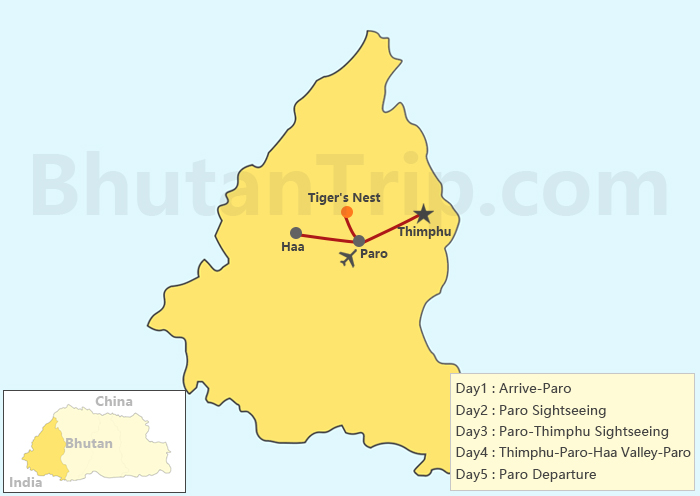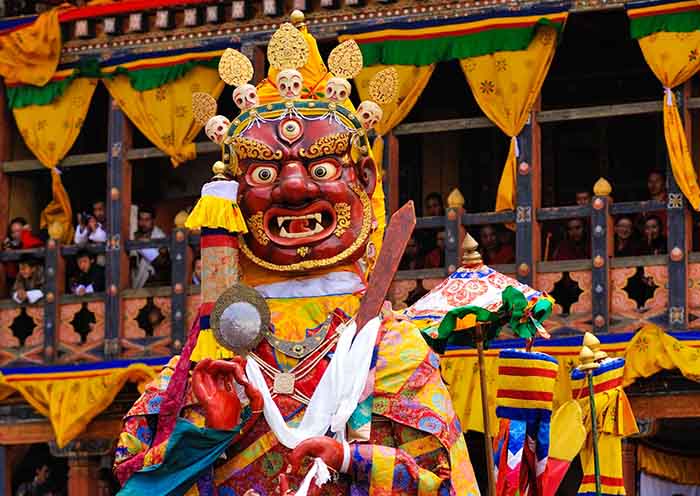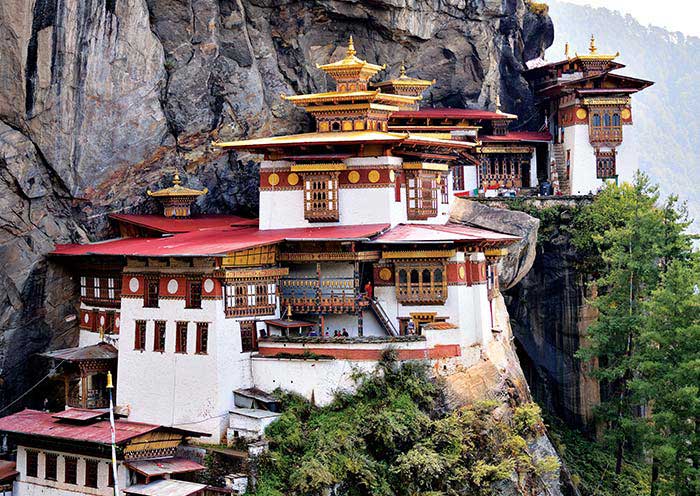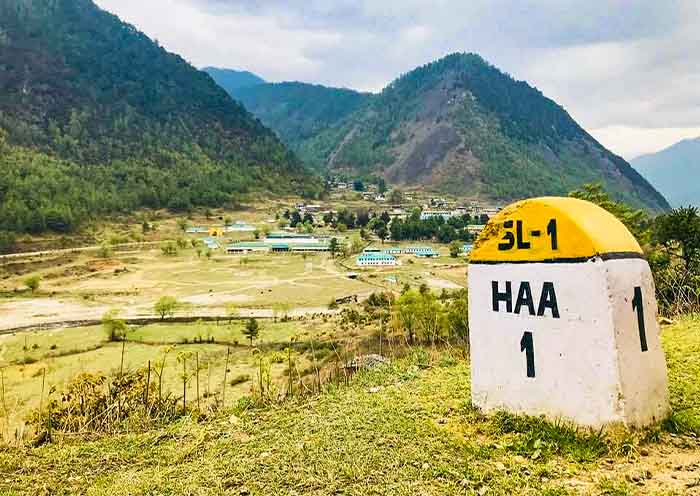Western Bhutan Trip with Haa 5 Days




 See More
See More
- Route:Paro-Haa-Thimphu-Paro
- Group Size:1-12 pax
- Tour Guide:English-speaking Guide
- Meals:4 Breakfasts, 3 Lunches, 4 Dinners
- Accommodations:4 Nights,3-Star Hotels
- Single Supplement:USD 160/pax
- Tour style:
Classic Bhutan Tour
From:USD1,050
317 Pax Booked
Highlights:
1. Paro Tour (3 Days): Paro Airport Birds Eye View Point, Bhutan Traditional Attire Experience, Tiger's Nest Monastery Hiking, Kyichu Lhakhang, Tamchog Lhakhang Iron Bridge
Paro Optionals (Free Time Ideas): Rinpung Dzong (Paro Dzong), Bhutan National Museum (Ta Dzong), Bhutan's National Sport (Archery), Paro's Local Market or Main Street, Horse Riding to Tiger's Nest Monastery, Bhutan Traditional Hot Stone Bath, Lighting Butter Lamps for Blessings at Kyichu Lhakhang
2. Thimphu Tour (1 Day): Buddha Dordenma Statue (Buddha Point), National Memorial Chorten, Motithang Royal Takin Preserve, Tashichho Dzong (Thimphu Dzong)
Thimphu Optionals (Free Time Ideas): Folk Heritage Museum, Simply Bhutan Museum, Stamp Printing at Bhutan Post Office
3. Haa Valley Tour (1 Day): Mini Tiger's Nest (Dzongdrakha Goempa), Chele La Pass (Mt. Jomolhari), Lhakhang Nagpo, Lhakhang Karpo
^ Western Bhutan Trip with Haa 5 Days (4 Nights) with the AOT's Bhutan Video.
Tashi Delek and welcome to Bhutan! Your local guide will greet you at the only international airport in Bhutan, located in Paro (2,262m) in Western Bhutan. Enjoy a panoramic view from the Paro Airport Bird's Eye View Point, offering sights of Paro International Airport, Paro Dzong, and Ta Dzong. Afterward, you can check in at your hotel for a restful stay as you adjust to the time difference.
Bhutan Standard Time is 6 hours ahead of Coordinated Universal Time (UTC+6).
Example: If it's 12:00 PM in Bhutan, it's:
6:00 AM in London, UK (UTC+0)
3:00 AM in New York City, USA (UTC-5)
8:00 PM the previous day in Sydney, Australia (UTC+10)
When visiting Paro in early to mid-March, you may attend the vibrant annual Paro Tshechu Festival, celebrating Guru Rinpoche's Birthday on the 10th day of the second lunar month in the Bhutanese Calendar, sometimes starting around March 10th or 15th.
Enjoy the following complimentary experiences from the AOT:
1. Bhutan National Dress Experience: Try Gho for Men & Kira for Women, reflecting the country's textile heritage.
2. A Bottle of Bhutan Red Rice Wine: Taste this traditional fermented beverage made from red rice.
Paro Optionals (Free Time Ideas):
1.If all group members arrive at Paro Airport before noon, consider visiting Rinpung Dzong (Paro Dzong) and Bhutan National Museum (Ta Dzong) as your first stops (self-pay for tickets). Paro Dzong operates from 9 AM to 5 PM on weekdays and 10 AM to 4 PM on weekends. Remember, a tour guide must accompany you.
2.Paro's Local Market or Main Street: Stroll through a local market to discover Bhutanese cuisine ingredients like colorful chili peppers, dry cheese, potatoes, and apples. Or explore the cute shops along Paro's tiny main street.
3.Bhutan's National Sport (self-pay for the experience): Archery, Bhutan's cherished pastime for over 2,000 years & targets set at a 140m range (double the Olympic distance of 70m), was declared the country's National Sport in 1971.
For personalized travel advice aligned with your interests, reach out to your guide in advance.
Meals: Dinner
Accommodation:Paro
- Try Bhutan's National Dress
- Paro Airport View
Today, we will drive from Paro City to the starting point of the hiking route to Tiger's Nest Monastery. The hike takes about 2.5 hours one-way (5 hours round trip), with a rest at a view terrace halfway along the trail. Alternatively, you can opt for a horse ride (self-pay) from the camp base to the Taktsang Cafeteria (lunch spot).
Tiger's Nest Monastery (Taktsang Goemba, Takhtsang Lakhang, Paro Taktshang), originally constructed in 1692, stands as an iconic landmark of Bhutan. Perched on a cliff at 900m above the Paro valley, legend tells of Guru Rinpoche (a Buddhist saint) riding a tigress to the current site of the monastery, where he meditated in a cave for 3 years, 3 months, and 3 days. Today, it remains one of Bhutan's most visited tourist attractions and a sacred pilgrimage site for Bhutanese to visit at least once in their lifetime. In April, witness the breathtaking sight of high-altitude rhododendrons blooming, painting the mountains with vibrant red clouds.
Notes:
1.Tiger's Nest Monastery Altitude: Situated at an impressive altitude of approximately 3,120 meters (10,236 feet) above sea level, this elevation may potentially lead to altitude sickness, although it is generally manageable for most guests. Rest assured, our guide is available to provide advice and support regarding high altitudes.
2.Tiger's Nest Hike: Approx. 5-6 hours, about 10 km round trip, highest altitude 3,150 m.
After the Tiger's Nest hike, it is time to explore Kyichu Lhakhang (Thousand-armed and Thousand-eyed Avalokiteshvara). This temple is one of the 108 Buddhist temples commissioned by King Songtsen Gampo in the 7th century (around 659 AD) to subdue a Tibetan witch's left leg. Inside the main hall of Kyichu Lhakhang, you can view a revered statue of an 8-year-old Shakyamuni Buddha, believed to have been crafted during the same period as the Jowo statue in the Ramoche Temple in Lhasa, Tibet, making it a national treasure of Bhutan.
Paro Optionals (Free Time Ideas):
1. Horse riding to Tiger's Nest Monastery: Horse Riding services are available to ascend partway up to Tiger's Nest Monastery, but you'll need to hike the remaining 1.5 hours to reach the monastery. Descending requires a full hike as horse riding services are not offered.
2. Bhutan Traditional Hot Stone Bath (1 hour): Complete your Bhutan experience with a traditional hot stone bath. This relaxing soak involves water heated by river stones on fire - a perfect post-hike treat.
3. Lighting Butter Lamps for blessings at Kyichu Lhakhang.
Meals:Breakfast Lunch Dinner
Accommodation:Paro
- Tiger's Nest in winter
- Tiger's Nest
In the morning, we will head to Bhutan’s capital city, Thimphu (72km, about 2.5h), via the Tamchog Lhakhang Iron Bridge. After sightseeing in Thimphu City (2,360m) with visits to the Buddha Dordenma Statue (Buddha Point), National Memorial Chorten, Royal Takin Preserve, and Tashichho Dzong (Thimphu Dzong), you can have a good rest at your hotel.
Tamchog Lhakhang Iron Bridge (view Tachog Lhakhang from outside only) is situated by the Paro river on the route to Thimphu from Paro. You can see a unique iron chain bridge with colorful fluttering prayer flags. Both the Lhakhang and the iron bridge were constructed by the saint Thangthong Gyalpo (1385-1464, a Tibetan Polymath). Known as the "Iron Bridge Maker," Thangthong Gyalpo is celebrated for his enduring architectural achievements that stand to this day. If fortunate, you may witness local pilgrims performing long kowtows or full-body prostrations during their five-day journey to Tiger's Nest Monastery from Tamchog Lhakhang.
Buddha Dordenma Statue (Kuenselphodrang, Buddha Point) is a prominent landmark of Thimphu offering captivating vistas of the Thimphu Valley. Standing at 51.5 meters in height, made of bronze and gilded in gold, this statue is renowned as the largest sitting Shakyamuni statue globally, housing 125,000 smaller Buddha statues within. Completed in 2015 after nine years of construction, the statue fulfills an ancient prophecy to radiate happiness and peace worldwide. During festivals, fortunate visitors can witness Buddhist rituals like the Vajra Dance Ceremony within the statue's premises or pilgrims pray on the square in front, while also enjoying panoramic views of Thimphu city and its green or red rooftops.
National Memorial Chorten, constructed in 1974 in memory of the Third King, His Majesty Jigme Dorji Wangchuk (the Father of Modern Bhutan) by his mother, is the most visited landmark in Thimphu. Conceived by Jigme Dorji, this stupa is dedicated to global peace and prosperity. Featuring Tibetan-style architecture with exquisite paintings and sculptures, the chorten showcases traditional stupa elements like the pyramidal pillar crowned by a crescent moon and sun. You can observe local Bhutanese circumambulating the chorten in a clockwise direction throughout the day for prayer.
Motithang Royal Takin Preserve (Takin Zoo, Takin Sanctuary) serves as a wildlife sanctuary for the Takin (Budorcas taxicolor), the national animal of Bhutan. Legend credits Drukpa Kunley (Divine Madman), the renowned Tibetan saint, with the creation of the Takin, a unique creature with a goat's head and a cow's body. In addition to the Bhutan Takin, you can also spot Himalayan Goral, Himalayan Serow, Himalayan Monal, Tragopan, Wild Pigs, Blue Sheep, Sambar Deer, Barking Deer, and Yaks in the area.
Tashichho Dzong (Thimphu Dzong), located on the right side of the Wangchu River in the northern part of Thimphu city, serves as the "Fortress of the glorious religion", housing the King's throne room, government offices, and the central monastic body. Initially constructed in 1641 and rebuilt by King Jigme Dorji Wangchuck in the 1960s, the Tashichho Dzong features two primary entrances - one leading to the administrative section to the south and the other (to the north) leading to the monastic quarter where the Thimphu Tshechu Festival (held around Sept. or Oct. yearly) and masked dances are performed.
Note: Thimphu Dzong is open to tourists from 5 PM to 6:30 PM on weekdays and from 10 AM to 4 PM on weekends. A tour guide is mandatory for visits, and security checks are conducted before entry. Lucky visitors may witness the flag descending ceremony if timed right.
You can enjoy a traditional meal at the Folk Heritage Museum Restaurant for dinner before head back to your hotel for overnight.
Thimphu Optionals (Free Time Ideas):
1. Folk Heritage Museum: If time permit, you can visit Folk Heritage Museum, a captivating window into Bhutan's rural past & established by the Queen Mother of Bhutan.
2. Simply Bhutan Museum: If time permit, you can visit Simply Bhutan Museum to explore more about Bhutan culture.
3. Bhutan Stamp Printing: Fully functional stamp printed with a self-portrait (Bhutan Post Office: Weekdays: 9AM - 5PM; Saturdays: 9 AM - 1 PM; Closed on Sundays).
Meals:Breakfast Lunch Dinner
Accommodation:Thimphu
- National Memorial Chorten
- Tashichho Dzong
This morning we will drive to Haa Valley, known as the "Hidden Land Rice Valley". After sightseeing with Chele La Pass, Mini Tiger's Nest (Dzongdrakha Monastery), Lhakhang Nagpo, and Lhakhang Kharpo, we will return to Paro (a round trip of 185km, about 6.5 hours).
Mini Tiger's Nest (Dzongdrakha Goempa) is a cliff-side temple complex on the western side of the Paro Valley. Built-in the 16th century by the first local king, Chogay Dragpa, legend has it that Guru Rinpoche first landed at Drakarpo, then Dzongdrakha before arriving at Paro Taktshang (Tiger's Nest). Dzongdrakha Monastery is often called the second Taktshang due to its strategic location offering panoramic views of Paro Bondey valley. Remember to explore the cave where Drubthog Gyonpo Dorji, the founder of the Lhakhang, meditated. From the Mini Tiger's Nest, you may also have the chance to see the planes arriving or departing from Paro Airport.
Chele La Pass (3,988m) is the highest motorable road pass in Bhutan, accessible by a two-hour drive from Paro. Known for its breathtaking views of the high Himalayan Mountains, you might catch a glimpse of Mount Jomolhari (6,706m), the most sacred peak in Bhutan, Jichu Drake, and the majestic Tsherimgang Mountains. Additionally, Chele La Pass is a prime spot to encounter the rare Blue Poppy (Bhutan National Flower) indigenous to this region.
Descending from Chele La Pass on the way to Haa Valley, you can spot Haa Dzong (Wangchuk Lo Dzong), an administrative center erected following the destruction of the old Dzong in 1915. Presently serving as the IMTRAT headquarters, it also hosts a military school and hospital.
Lhakhang Nagpo (The Black Temple) is a 10-minute walk from Lhakhang Karpo. Legend has it that in the 7th century, Tibetan King Songtsen Gampo released white and black pigeons to designate temple sites. Lhakhang Nagpo stands where the black pigeon landed, with its walls painted black with red and white horizontal stripes symbolizing ancient tantric practices in the valley.
Lhakhang Karpo (The White Temple), one of the oldest temples in the region, sits at the foothills of the Meri Puensum mountains. Adorned with intricate murals and paintings reflecting kindness and Dharma values, this temple was allegedly built by King Songtsen Gampo where the white pigeon landed. You might encounter trumpets crafted from human thigh bones (Buddhist ritual objects) in this temple. During the Haa Summer Festival held annually in July, religious performances (mask dance) can be witnessed in the square.
After exploring Haa town, return to Paro for the night.
Meals:Breakfast Lunch Dinner
Accommodation:Paro
- Haa Valley
- Chele La Pass
Time to bid farewell to Bhutan, the stunning Himalayan country. Your guide will meet you at your hotel and escort you to Paro International Airport (50km, 1.5h). Happiness is a destination; we hope you have found happiness and cherished memories during your trip in Bhutan with us. We eagerly anticipate your return. Tashi Delek!
Extension Ideas: If you wish to explore more of Bhutan, consider extending your trip to include other captivating destinations such as Punakha, Gangtey, and Bumthang.
Meals:Breakfast
Accommodation:/
- Thimphu Street with no traffic light.
- Thank you for choosing us.
Price Includes
- 1.Meals listed in the itinerary
- 2.Accommodation in 3-star hotel under twin/dbl bed sharing basis
- 3.All transportation within the country including airport transfers
- 4.English-speaking local guide
- 5.Entrance fees for Museums and Monuments
- 6.Bhutan SDF fee
- 7.Bhutan Visa fee: USD 40 per person
Price Excludes
- ✖1.Single room supplement charges
- ✖2.International flights before and after the tour
- ✖3.Personal expense and Travel Insurance
- ✖4.Cost for any services not mentioned in the "PRICE INCLUDES"
Arrival Information:
To reach Bhutan, fly to Paro International Airport or enter by land through Phuentsholing or Gelephu from India. Airlines like Druk Air, Bhutan Airlines, and others operate regular flights to Paro from major cities like Delhi (India), Kolkata (India), Bagdogra (India), Gaya (India), Guwahati (India), Dhaka (Bangladesh), Bangkok (Thailand), Kathmandu (Nepal), and Changi (Singapore). Charter flights are available from Hong Kong and Kuala Lumpur seasonally.

Kindly Note:
Contact us to book flights directly to Bhutan (Bhutan Airlines).
Non-Indian nationals need an E-visa ($40) to enter.
Indians require a permit with an Indian passport or voter ID.
Visitors from Bangladesh and the Maldives need a visa, obtainable in advance or upon arrival.




















